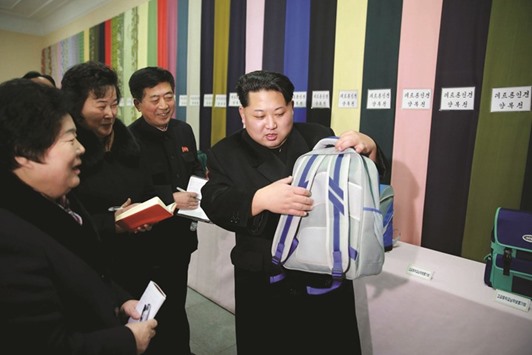North Korea may be preparing a long-range ballistic missile launch, Japanese media said yesterday, following a nuclear test this month that raised international alarm and sparked a diplomatic clash between Washington and Beijing.
Imagery collected over the past several days suggested the launch from the western Dongchang-ri site could come in about a week, Kyodo News said, citing a Japanese government source it did not identify.
Increased movements of people and vehicles were seen around the launch site, which has now apparently been covered over, national broadcaster NHK said, citing a source familiar with Japan-South Korea relations.
The United States regularly monitors North Korea from space while Japan itself began its own satellite monitoring of the country in 2003.
North Korea is banned under UN Security Council resolutions from carrying out any launch using ballistic missile technology, although repeated small-range missile tests have gone unpunished.
The development parallels events in December 2012, when Pyongyang put a satellite into orbit with its Unha-3 carrier.
Eight days before the 2012 launch, the North also put up a covering over the facility to hide the work from the view of satellites, NHK said.
The reported preparation of a missile launch came amid a flurry of diplomatic activity over possible further sanctions against Pyongyang for conducting its fourth nuclear test earlier this month.
Pyongyang said the blast was a miniaturised hydrogen bomb, though experts have largely dismissed the claim.
Washington is pushing for a strong United Nations response, including enhanced sanctions.
But China, North Korea’s chief diplomatic protector and economic benefactor, is reluctant, despite ties becoming strained in recent years as Beijing’s patience wears thin with its neighbour’s ambitions for nuclear weapons.
US Secretary of State John Kerry met with his Chinese counterpart Wang Yi in Beijing on Wednesday and said they had agreed to mount an “accelerated effort” to try to resolve their differences on a new resolution.
But Kerry, who said nuclear-armed North Korea poses an “overt threat, a declared threat to the world”, acknowledged that the two had not agreed on the “parameters of exactly what it would do or say”.
South Korean defence ministry spokesman Kim Min-Seok declined to confirm or deny the Japanese reports, saying the ministry did not comment on intelligence matters.
He added, however, that South Korea’s military was monitoring for any signs of a long-range missile launch.
“In the past, North Korea always fired a long-range missile ahead of a nuclear test. But since it didn’t this time, we are concerned that it could launch one” afterwards, Kim said.
Kim also stressed that Pyongyang used to notify China and the US before carrying out nuclear tests, though this time did not.
“We believe that North Korea could launch grave provocations by surprise -- without pre-warning -- from now on.”
In Tokyo, deputy chief cabinet secretary Koichi Hagiuda also kept generally tightlipped, but said: “We will continue to gather information and carry on surveillance work so that we can deal with any and all situations.”
The possible preparation of a missile launch also came after the North said it carried out a submarine-launched ballistic missile test in December.
Pyongyang hailed that test as a great success and released a video that researchers at the California-based James Martin Center for Nonproliferation Studies concluded had been heavily doctored and edited to cover up a “catastrophic” failure.
Many experts say Pyongyang is still years away from obtaining a credible intercontinental ballistic missile capability.
“North Korea is still a long way off from being able to strike the US mainland,” one of the world’s foremost authorities on North Korea’s nuclear programme, Siegfried Hecker, said in an interview published after the North’s last nuclear test.

North Korean leader Kim Jong Un provides field guidance to the Kim Jong Suk Pyongyang Textile Mill, in this undated file photo released by North Korea’s Korean Central News Agency


